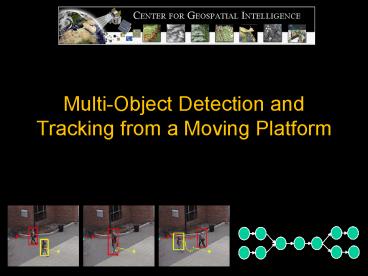MultiObject Detection and Tracking from a Moving Platform - PowerPoint PPT Presentation
1 / 19
Title: MultiObject Detection and Tracking from a Moving Platform
1
Multi-Object Detection and Tracking from a Moving
Platform
2
Tracking from a Moving Platform
- 1-Analysis and detection
- Registration across video group of frames (VGoF)
- Detection and segmentation of motion blobs
(background models, shadow) - 2-Representation and tracking
- Video object representation (shape, color
descriptors, geometric models) - Object tracking (prediction, correspondence,
occlusion resolution etc.) - 3-Access and event modeling
- Efficient data structures for video queries in
high-dimensional feature space - High-level event representation
3
Multi-Object Tracking
- 1. Detect moving objects in stabilized frames.
- 2. Predict locations of the current set of
objects. - 3. Match predictions to actual measurements.
- 4. Update object trajectories.
- 5. Update image stabilized ref coord system.
Multi-object Detection and Tracking Unit
Tracking
VGoF Registration Into Common Coordinate System
Moving Object Detection Feature Extraction
Data Association (Correspondence)
Update Trajectories
Object States
Update Coord System
Prediction
Context
4
Dynamic State Estimation for Tracking
System state
State estimate
Measurements
Dynamic System
Measurement System
State Estimator
State uncertainties
System noise
Measurement noise
- System Errors
- Agile motion
- Distraction/clutter
- Occlusion
- Changes in lighting
- Changes in pose
- Shadow
- (Object or background models
- are often inadequate or inaccurate)
- Measurement Errors
- Camera noise
- Framegrabber noise
- Compression artifacts
- Perspective projection
- State Error
- Position
- Appearance
- Color
- Shape
- Texture etc.
- Support map
5
Motion Detection- 3D Spatiotemporal Volume
Spatio-temporal volume of hall monitor sequence
(a) Left entire volume, (b) Middle cut taken at
vertical position y0, (c) Right Cut taken at
vertical Position y1.
Gerald Kuhne, Motion-based segmentation and
classification of Video Objects Dissertation
Univ. of Mannheim, 2002
6
Motion Detection - Structure and Flux Tensor
Approach
- Typical Approach threshold trace(J)
- Problem trace(J) fails to capture the nature of
gradient changes and results in ambiguities
between stationary versus moving features - Alternative Approach Analyze the eigenvalues
and the associated eigenvectors of J - Problem Eigen-decompositions at every pixel is
computationally expensive for real time
performance - Proposed Solution Flux tensor ?? time derivative
of J
7
Motion Detection Flux Tensor vs Gaussian Mixture
8
Multi-object Tracking Stages
- Probabilistic Bayesian framework
- Features Used in Data Association Proximity and
Appearance-based - Data Association Strategy Multi-hypothesis
testing - Gating Strategies Absolute and Relative
- Discontinuity Resolution Prediction (Kalman
filter), or Appearance models - Filtering Temporal consistency check and
Spatio-temporal cluster check
9
Association Strategy
- Multi-hypothesis testing with delayed decision -
Many matches are kept with evidence-based pruning - Support for multiple interactions - one-to-one
object matches, many-to-one, one-to-many,
many-to-many, one-to-none, or none-to-one matches
- Corresponding low-level object tracking events
- Segmentation errors
- Group interactions (merge/split)
- Occlusion
- Fragmentation
- Entering object
- Exiting object
ObjectMatchGraph
10
Match Confidence Computation
- Match confidence quantifies correspondence
goodness-of-fit - Confidence value has two components
- Similarity confidence (Confsim)
- Separation confidence(Confsep)
?1,j is the closest competitor in terms of
distance
Conf(i,j)
Link
Nodei
Nodej
- bounding box
- support map
- centroid
- area etc.
- bounding box
- support map
- centroid
- area etc.
11
Trajectory Segment Generation
- Trace links in the ObjectMatchGraph to generate
possible trajectory segments - SegmentList - Linked list of inner nodes
(objects/cells) - Trajectory labeling - Extracted trajectory
segments are labeled using a modified connected
components labeling - Trajectory linking - Trajectories are formed by
linking unfiltered segments sharing the same
label.
Trajectory
ObjectMatchGraph
12
Data Hierarchy
Node (Object-Region)
Segment
Macro segment
Trajectory
13
Need for Local Registration
14
Exp Results DARPA ET01 Video Frame 50
Registered Frame
Motion Detection Results
Foreground Mask
Tracking Results
15
Exp Results - NGA Crystal View HD Video Frame
787 in Coord. 740
UPS
c) Predictions
d) After occlusion handling
16
Future Work - Trajectory Matching and Filtering
- Establishing trajectory continuity (object ID
matching) across moving coordinate systems - Customizing trajectory analysis for airborne
video tracking with misregistration error, large
platform motion, zooming, etc - Maintaining temporal consistency of trajectories
- Removing periodic clustered trajectories
- Resolving discontinuous trajectories
- Trajectory display and visualization video vs
mosaic
17
Future Work Performance Optimization and Tuning
- Moving object detector filters
- Flux tensor fixed optimal threshold learning or
continuous adaptive thresholding - Morphological post processing filters
- Real-time versus offline MATLAB (approximate)
- Flux tensor detection 4sec/frame
- Object tracking 2sec/frame (for around 10
objects) - Excluding I/O time
18
Future Work - Near Term Performance Improvements
- Frame-to-frame registration accuracy difficult to
maintain across a hundred frames or more (few
seconds of video) - Reducing false motion trajectories due to
registration errors due to scene structure - Maintaining a common coordinate system for
registering long airborne video sequence - Tracking through large platform motion
- Dealing with large camera field-of-view changes
- Platform motion jitter
19
Future Work - Longer Term Performance Improvements
- Filtering periodic motions produced by clutter,
etc. - Shadows (e.g. false detections, shape
distortions, merges) - Sudden illumination changes (e.g. due to cloud
movements) - Glare from specular surfaces (e.g. windshields,
water surfaces) - Perspective distortion (e.g. object size, shape
and position) - Trajectory gaps and distortion due to occlusion
- Poor video quality (e.g. low resolution, low
color saturation)































